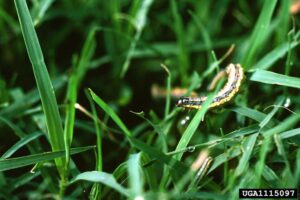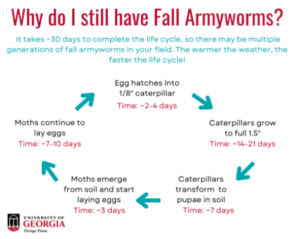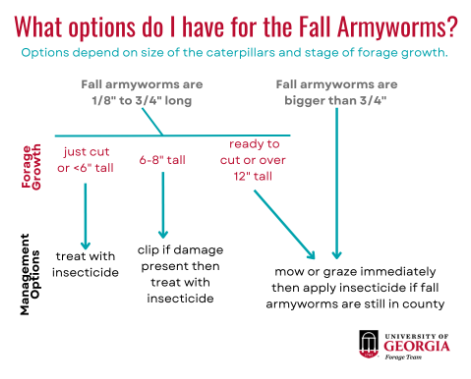
Heather N. Kolich, ANR Agent, UGA Extension Forsyth County
Fall armyworms are an annual pest of pastures, hay fields, and lawns. They are actually caterpillars, not worms. The moths that lay the eggs that hatch into these grass-eating caterpillars hop-scotch north from Florida on spring and summer weather fronts. They land in pastures, fields, and lawns and lay eggs. After only a few days, the eggs hatch and the new generation of caterpillars spends the next 14-17 days consuming grass and causing significant damage and yield loss. Then they pupate in the soil, metamorphosize, and emerge as reproductive moths that fly to the next grassy field and repeat the cycle.
Fall armyworms usually reach north Georgia in late summer or early fall, but they are early and abundant this year. Early arrival means that multiple treatments may be necessary to control progressive generations.
Fall armyworm control recommendations for forage growers

UGA forage specialists sent a Fall Armyworm Alert to agents this week. Here is a distillation of their armyworm control concerns and recommendations for forage growers. Some pesticides mentioned below may only be available to agricultural producers with a current Georgia Department of Agriculture pesticide applicator license.
- Control of fall armyworm (FAW) is most effective on worms less than one inch long.
- Chemicals are more effective as treatments in short grass than in tall grass.
- Pyrethroids have been declining in effectiveness for several years. Florida producers have documented FAW populations with resistance to these products.
- Spinosad products still provide good control of FAW, but cost more than pyrethroids.
- Pyrethroids and spinosad kill by contact with the product and/or ingestion of treated grass by the caterpillars.
- Insect growth regulator (IGR) products such as diflubenzuron (the active ingredient in Dimilin) and methoxyfenozide (Intrepid) are effective against caterpillars but not moths. They don’t kill outright; instead, they prevent the caterpillars from developing to the next instar or phase of growth. Dimilin has a 1-day preharvest interval for cutting hay and is restricted to application of no more than 2 ounces per cutting.
- IGRs can be tank mixed with pyrethroids to good effect.
- Vantacor, Prevathon, and Besiege are diamides that target specific receptors of moth species. The active ingredient is taken up by and moves around in grass blades, providing protection in new growth for up to 2-3 weeks. These products cost more and take time for full effect, but they also provide extended control with one application. Besiege contains a pyrethroid to combine a quick start and long action.
- If you have large FAW in tall grass, chemical control is unlikely to be effective. The best course of action in this case is to cut the grass for hay if it’s close to harvestable, then use chemicals to treat the regrowth. Once you cut the grass, the worms don’t have feed and will either pupate or move elsewhere.
- Carbaryl [Sevin] has a 14-day post-application restriction on grazing and hay cutting.
- Not recommended: Methomyl (found in Lannate) is highly toxic and labeled only for use on bermudagrass.
For more resources, visit the UGA Extension Forage Team at https://site.extension.uga.edu/forageteam/fall-armyworm-resources/.
Fall armyworm control for lawns



The cultural considerations for pastures are the same for lawns: Chemicals are more effective on small FAW than large ones and a good, even application of pesticide is more possible in short grass than in long grass.
Pyrethroids and spinosad products are options for residential lawns. Bacillus thuringiensis is an organic option for FAW that are less than ½ inch long.
Before treating lawns, mow and irrigate them lightly. Time the treatment for morning or early evening when FAW actively feed.